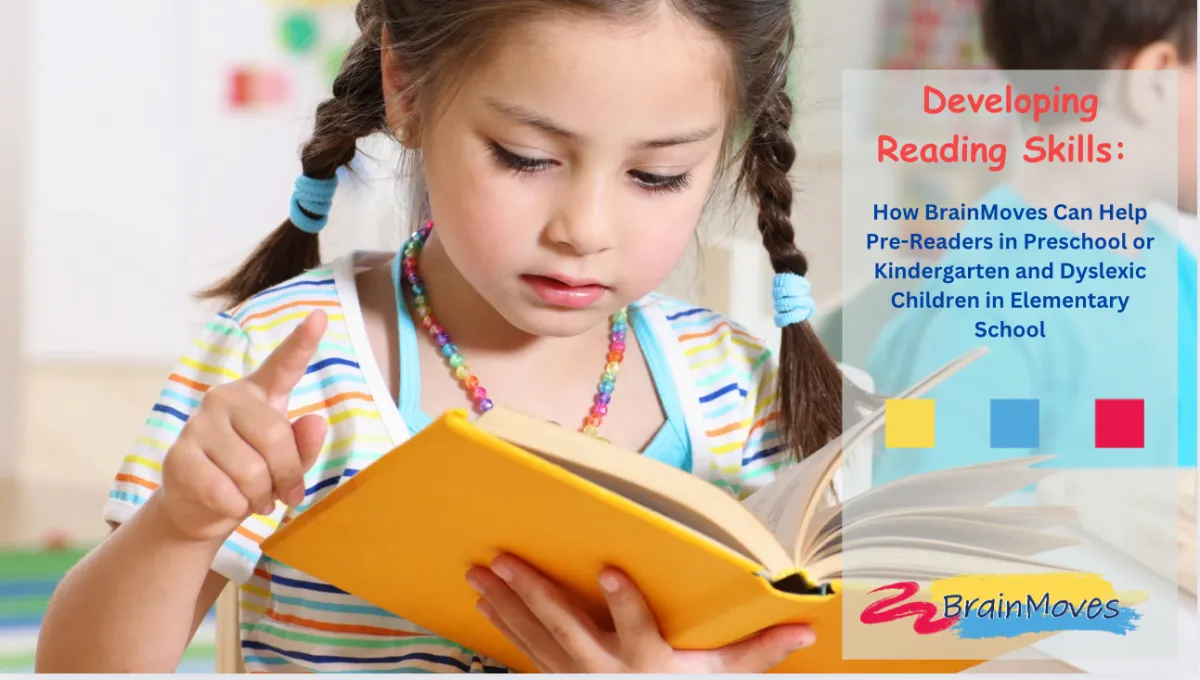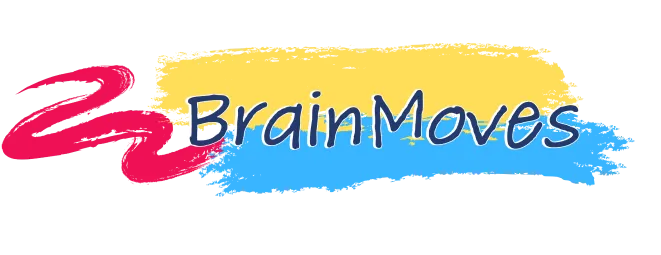
Developing Reading Skills: How BrainMoves can Help Pre-Readers in Preschool or Kindergarten and Dyslexic Children in Elementary School
Before children learn to read, they progress through phases of understanding how written language works. First, they learn to speak, make sounds, and then form words that gain meaning. This lets preschoolers express complex thoughts and stories. By this stage, children are also more aware of present, past, and sometimes future events. However, patience and understanding of future events may still be developing. This is important because to read, children must learn that shapes mean sounds, sounds make words, and that written and spoken words share meaning.

As children recognize shapes as sounds, specific neural pathways are activated, strengthening the connections between visual and auditory understanding. This strengthens the brain's ability to map visual symbols to their corresponding sounds, a crucial cognitive leap in literacy. A child sitting at the kitchen table, tracing the letter 'm' on a sheet of paper while saying 'mmm' aloud builds their neural pathways, reinforcing the connection between seeing the shape and producing the corresponding sound is doing important skill building.
Parents can help develop preschool literacy by practicing listening, distinguishing sounds, saying them aloud, and tracking words in sequence with their children, instead of just noticing what stands out first. Adults know to start at the top left, read rightward and downward on a page, while viewing a painting often begins wherever the eye is drawn. Learning to scan text and form sentences is a skill, just like connecting sounds to letters. To ensure progress, observe if your child begins pointing from left to right while reading, or starts differentiating between similar sounds. These cues can indicate that the listening and tracking practices are effectively enhancing their pre-literacy skills.
Children engage in pre-literacy activities by noticing print, holding a book, turning its pages, or navigating an e-book. When children watch adults read, they see that text carries meaning and is important—even if the adult is reading silently.
How do BrainMoves movements help the brain? Children need both gross and fine motor skills to hold a pen and draw imagined shapes. Tracing shapes helps build these skills and improves eye tracking. Once a child can draw the letter O, they are encouraged to make the O sound, which may vary depending on their accent. Early on, the O sound may be hard to distinguish from other vowels, but with practice, children learn to hear the differences. Simple movements, like relaxing neck muscles, can help children process sounds, speak comfortably, and learn more easily.
Stage 1: Print Awareness. At this stage, children become aware of the existence and purpose of printed text. They learn foundational skills, such as how to hold a book and begin to understand page-turning. The next challenge is to turn pages smoothly and understand that the text carries meaning. To improve motor skills and body awareness for holding a physical object, do the BrainMoves Squirrel movement.

Stage 2: Oral Language Development. Through listening and speaking, children expand their vocabulary and develop a grasp of sentence structure, grammar, and storytelling. To help a child listen and process sounds, do the Koala Cub movement.
Stage 3: Phonemic Awareness. From oral language, children move to phonemic awareness by recognizing that spoken words are made up of individual sounds (phonemes) and beginning to identify rhyming words and syllables. The Koala Cub will help the child press and understand sounds; the Blowfish can help your child make the letter sounds and mimic your sounds more easily.
Stage 4: Letter Recognition. Once phonemic awareness develops, letter recognition follows. Children learn to identify and name the letters of the alphabet, both uppercase and lowercase, and may begin to associate some letters with their corresponding sounds. Often, letter recognition is helped by having the child trace the shape of letters and numbers. To make this practice fun, frame it as a 'mini-game' where tracing letters becomes playful project: Ask the child to use some of the BrainMoves Coloring pages in addition to the letter tracing. Movements that help with the grasping reflex and eye tracking can be made gentle and fun. The Red Crab, Green Crab, and Blue Crab can be turned into a timed challenge, providing both practice and enjoyment in building trace, eye tracking, and fine motor skills.
Stage 5: Emergence of Early Writing Skills. Early writing skills begin to emerge after letter recognition.Children experiment with writing by scribbling, drawing, and eventually attempting to form letters and simple words.
Oral language skills develop through listening and speaking. Hearing another language at home increases

vocabulary and awareness of sounds that might appear later when studying a language. Once children have developed oral skills, they progress to phonemic awareness, which involves understanding that spoken words are composed of individual sounds and being able to identify rhymes and syllables. This helps them distinguish similar sounds. Letter recognition is often taught in conjunction with phonemic awareness. Children are typically encouraged to learn the uppercase letters first, followed by the lowercase letters, starting with letters from their own names and family names.
To build skills, introduce similar-looking letters, like M and N or V, W, and U all at the same time, so children practice telling them apart. Eye tracking helps because knowing words are read left to right makes confusion less likely. Children enjoy mimicking adults and older kids, so let them scribble, draw, trace, or color letters as they learn to make letter shapes. Early scribbling may not relate to reading, but soon they’ll use these skills to sign their names and recognize important words they’re comfortable with.
Doing BrainMoves with your child while they work on worksheets or draw can help them improve their eye tracking, sound, and shape recognition. These simple movements are easy to learn and perform, and can help both pre-readers, such as preschoolers, and older
elementary school children with learning challenges like dyslexia or number issues like dyscalculia. As a parent, imagine your child's school work being more peaceful and easier with just a few minutes of practice a day. Practicing these skills for just ten minutes a day can help your child develop the ability to listen and learn.
EAGER TO LEARN MORE? Check out a BrainMoves workshop or purchase the self-paced online course and work through all of the movements at your own pace. Imagine seeing significant improvement in your child's skills in as little as two weeks. This small time investment could make a big difference. To get started quickly, follow the link below to sign up for the online course and experience BrainMoves firsthand. https://thebrainmovescourse.com/#custom-code-h8-M12CN4iJ

